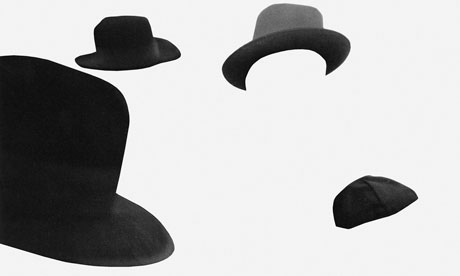Mishka Henner, Less Americains, Open Eye Gallery in Liverpool.
(inkjet prints)
I found the photographs in this exhibition extremely beautiful, very moving, thought provoking and intriguing. They look like surrealist puzzles, with so much omitted and left unsaid. Henner has appropriated 83 images from Robert Frank's book Les Americains, erasing much of the original content, leaving blank outlines where once there were faces, people, buildings and landscape.

In doing this he has used two controversial conceptual approaches: appropriation and erasure. Questioning the very nature of documentary photography and its integrity, through the lens of an abstract expressionist, he has played with shape and texture, resulting in a series of images that are ghostly with props foating in an empty frame. The focus is moved away from the production of images and is directed instead at the value of images, asking really interesting questions about appropriation and inspiration.
'Though I wouldn't call myself a conceptual artist, the movement smashed through so many pretensions and facades that it appealed to me in a big way, especially in the work of appropriation artists. It was still documentary to me, but not as we knew it ... Now, I'm happiest when I'm making something that doesn't look or feel like documentary photography but still manages to address a social context.'
Marcel Duchamp was the first artist to use what he called 'readymades' and appropriated art. Warhol and Basquiat used each other's images to create works of art - they used to deface each other's drawings and paintings and scribble all over them.
More recently, Jake and Dinos Chapman bought a set of Goya prints, the most revered series of prints in existence, Disasters of War, and vandalised them - and I have used this word intentionally. 'We've gone very systematically through the entire 80 etchings and changed all the visible victims' heads to clowns' heads and puppies' heads', commented Dinos Chapman. This 'new' work they called Insult to Injury and it was exhibited at Modern Art Oxford, under the title of The Rape of Creativity - an apt title if there ever was one. I try to be open about new developments in art, but this is going too far.
Goya's Disasters of War is a pasterpiece, its images so relevant and so truthful, it is the ultimate anti-war statement. Being far too anti-clerical and unpatriotic to be published in his lifetime, the first ever edition came out in 1863, three and a half decades after his death. It is as fresh and relevant today as it was in the 18th and 19th centuries. I wonder if anyone will have heard of the Chapman brothers is two centuries' time?
Postmodern appropriation artists argue that the notion of an original is flawed and that by reappropriating existing works, artists are able to place a work of art in a different context and thus open up new dialogues on the piece.
It's so difficult taking pictures of photographs in galleries, the light and the reflection from the glass always get in the way - my photographs certainly don't do these photographs justice.
Source: Mishka Henner's Erased Images, The Guardian, 23.5.2012









No comments:
Post a Comment